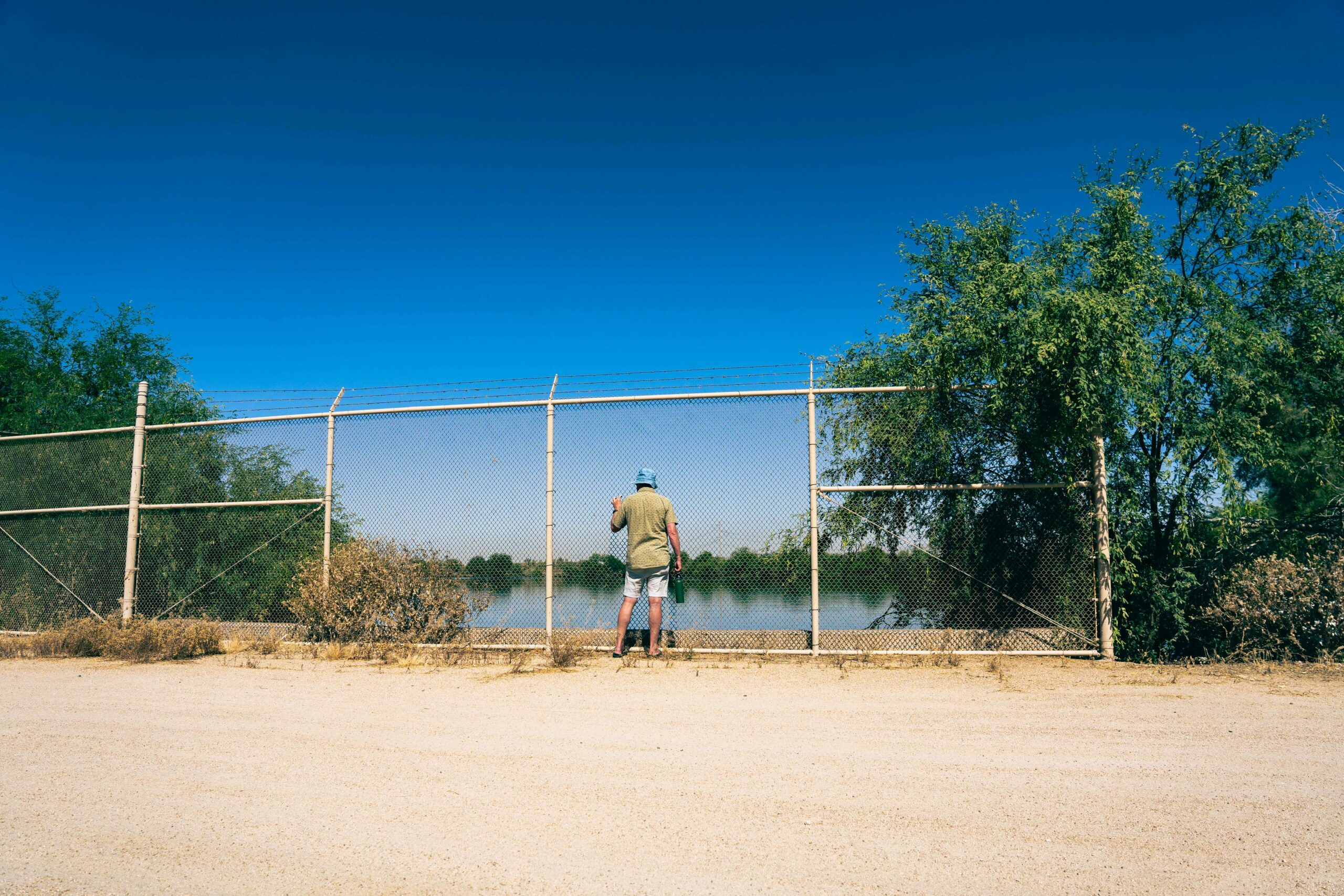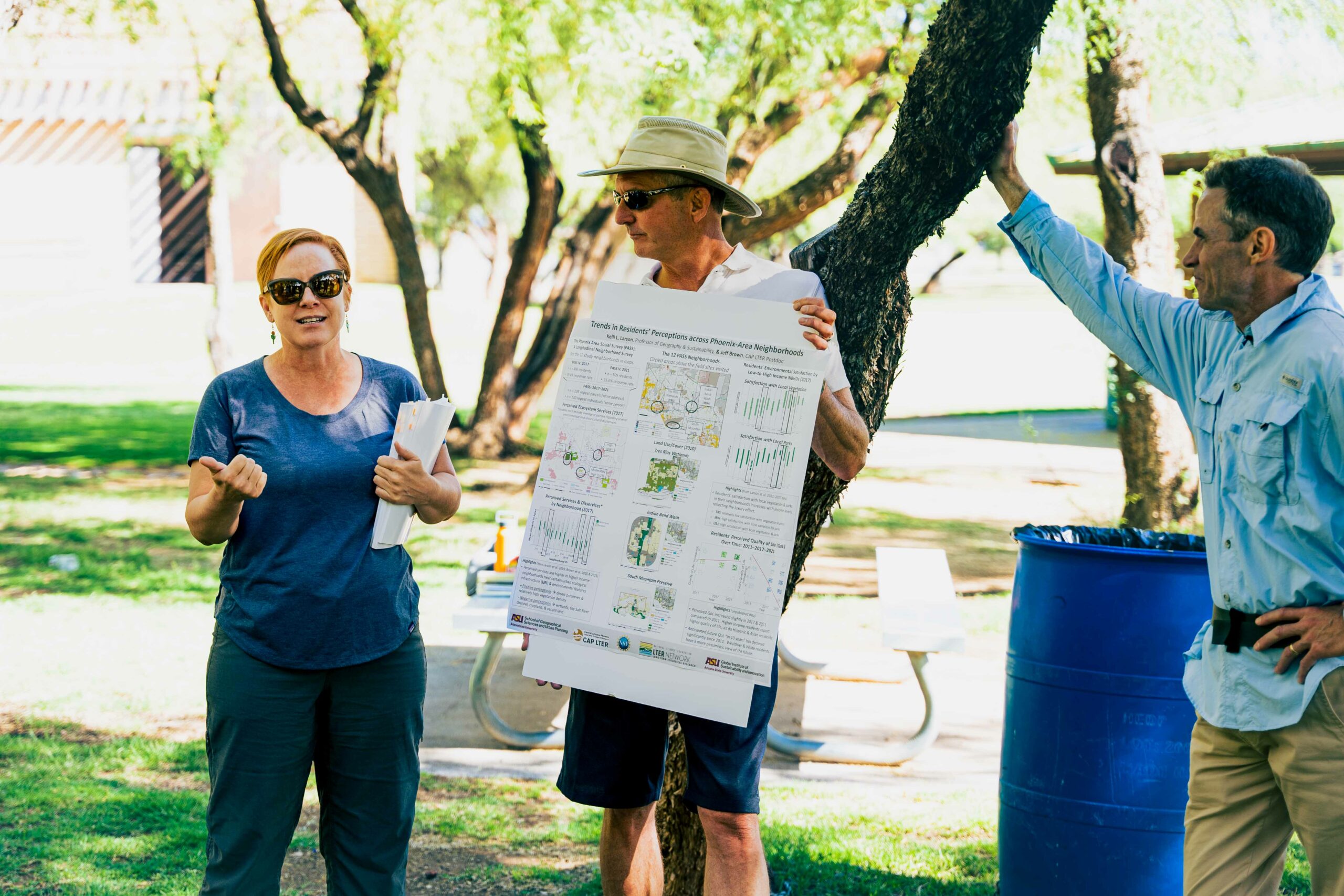At the Central Arizona Phoenix (CAP) LTER site, the Phoenix Area Social Survey uncovers residents’ relationships to the landscape around them, ultimately revealing drivers of urban environmental change. In parallel with ecological research at the site, the survey has revealed surprising mechanisms of change, challenged long-held assumptions, and demonstrated residents’ connection to long-term ecological trends.

In Phoenix, the city’s ecology is driven by human activity. Take the Tres Rios constructed wetland, pictured here, for example. Constructed primarily for effluent remediation, the wetland is a stunning oasis in the desert, home to vibrant plant life and a huge diversity of bird species.
Credit: Gabriel De La Rosa, CC BY-SA 4.0
Heating Up
Heat defines the Phoenix urban ecosystem. Yet heat within the city is unevenly distributed, where local infrastructure can magnify (concrete) or mitigate (trees) the temperatures on the ground.
Phoenix residents can implement different strategies to combat heat. They might plant and water a lush yard, or advocate for green spaces in their neighborhood. But do hotter areas lead to more lawns, and ultimately change the urban landscape in ways that might in turn affect plants, animals, and people?
The Central Arizona-Phoenix LTER site implements the Phoenix Area Social Survey (PASS) to study the relationships Phoenix residents have with their local environment. The survey is a key companion to the long-term ecological research at the site: in urban ecosystems, human actions are the drivers of environmental change.
In 2016, researchers at the CAP LTER linked heat perceptions from the PASS survey to land cover temperatures at local scales. They found that residents’ perceptions of heat aligned with actual temperature on the ground, suggesting perceptions of heat are defined at the local, rather than regional scale—and highlighting that local heat mitigation strategies, such as local parks or vegetated yards, might have a positive effect on residents’ lives.

Dr. Kelli Larson (left) explains the Phoenix Area Social Survey to visiting LTER scientists at the 2022 Science Council Meeting in Phoenix. Central Arizona-Phoenix (CAP) LTER Lead PI Dr. Dan Childers (center) holds her poster, and CAP LTER Information Manager Dr. Stevan Earl (right) looks on.
Credit: Gabriel De La Rosa, CC BY-SA 4.0
Yet residents in hot areas weren’t any more likely to implement heat-mitigation strategies, like planting vegetation: a subsequent study found that while residents’ perceptions of heat again correlated with actual temperatures on the ground, there was little correlation between heat and heat mitigating infrastructure. Rather, economic status and homeownership determined the prevalence of cooling infrastructure.
The heat results reveal important considerations for policy that affects the local landscape. And the CAP LTER is well poised to influence local action, at least towards heat mitigation. Recently, CAP researcher Dr. Dave Hondula was elected to Phoenix’s Heat Response and Mitigation Office. His appointment provides a direct link between the socio-ecological research at CAP and citywide policy.

The Phoenix landscape is a patchwork of natural, semi-natural, and urban areas. Here, a mid-city agricultural plot sits between residential zones.
Credit: Gabriel De La Rosa, CC BY-SA 4.0
Who controls the Phoenix lawn?
The PASS focuses on a wide variety of topics in addition to heat, and surprising, revealing results pop up everywhere.
Results from the PASS, garnered through a series of questions focused on residents’ yards, challenge a common assumption that residents’ preferences dictate their landscaping choices. “What the data have actually shown is that despite a shift away from lawns, some people want more grass than they have,” says Dr. Kelli Larson, lead social scientist of CAP and the director PASS, speaking of work published in 2020.
Even though the city has seen widespread adoption of low-water xeric landscaping and yards with no or low grass, “it’s far more than preferences that are driving these landscape changes,” she continues.
The residential landscaping research is another good example of the importance of socio-ecological science, Dr. Larson says. The survey has the ability to reveal how local context might lead to certain relationships or outcomes, which can feed back into effective campaigns or policy.
For example, Larson notes that a recent campaign to get residents to “Use Water Wisely” in Phoenix is likely ineffective in actually changing landscape choices or water-use behaviors. “People have been saying, ‘we’re changing the city by first changing the culture!’” says Dr. Larson. “In reality, [peoples’] preferences often don’t affect what [they] actually have” in their yards. Rather, her research shows that existing yards are commonly a function of the legacies of past landscaping decisions made by developers or previous homeowners.
The survey occasionally challenges deeply-held ecological beliefs
Sometimes, results from the survey challenge assumptions by the scientists themselves. One recent study used the PASS to show that not all types of open spaces or urban-ecological infrastructure like river channels garnered favorable attitudes from Phoenix residents.
A revealing comparison from the study is that residents thought that open desert spaces provided beneficial services, but wetlands did not—even though wetlands play an important role in flood and stormwater mitigation. Whereas an ecologist may value a wetland for flood mitigation, a resident probably will not. “Unless you’re along an improved section of the Salt River, [wetlands] are areas that are not seen as providing ecosystem services or valued for their aesthetics,” says Dr. Larson.

Another view of the Tres Rios Constructed Wetland. Though its main function is to remediate the nutrient pollution after wastewater is treated, the park provides a variety of ecosystem services to Phonecians, including vibrant birding, a beautiful landscape, and the oh-so needed cooling effect from the water.
Credit: Gabriel De La Rosa, CC BY-SA 4.0
Now 16 years old, the survey contains enough data to link long-term trends in peoples’ perceptions and values to long-term trends in ecology. For example, researchers found that as urban bird diversity declined over time, so did residents’ satisfaction with the local bird community.
Key to long-term results, the PASS survey is designed to leverage concurrent long-term ecological research from the CAP LTER. In this case, researchers implemented neighborhood social surveys in areas with ongoing long-term bird counts. In 2016, the survey was reformatted to focus more deeply on neighborhoods with existing CAP work to stress the socio-ecological overlap.
In the bird study, researchers found strong links between residents’ perceptions of birds and bird diversity, both in local snapshots and over time. Residents in high bird diversity neighborhoods were more likely to appreciate local birds than those in low diversity neighborhoods. But as bird diversity declined over time, so did residents’ overall appreciation for the birds around them. The result shows a strong link between social trends and ecological trends in Phoenix, at least for birds.
This is an early publication from a growing research contingent at CAP, says Dr. Larson. Several other colleagues are studying human-wildlife interactions and how they influence people’s attitudes toward different species and residents’ willingness to live with them. Preliminary results from this work show that communities near wildlife preserves are more likely to view coyotes or snakes favorably. Other work is exploring how different communities approach snake removal, which directly alters urban ecology.
A long-term survey continues to bear fruit
The PASS is slated to continue well into the future, with repeat surveys conducted every six years. Larson is most excited about how results from the survey can inform stronger environmental management in the city. “Perceived risks and management solutions differ between the residents, policymakers, and scientists,” she says. The PASS lets her and her colleagues dig deep into the nuance of local perception and uncover what’s driving change in the urban ecosystem—and ultimately, track those changes over long timescales.
By Gabriel De La Rosa










